Related Research Articles
Patnayak/ Pattnaik/ Pattanayak/ Pattnayak/ Patnaik is a native Odia surname found in states like Odisha, northeastern districts of Andhra Pradesh and southern districts of West Bengal in India. This surname is mainly found in Karana community of Odisha. Tadhau Karana servitors of Jagannath Temple, Puri belonging to Karana community mainly use the title "Pattanayaka".
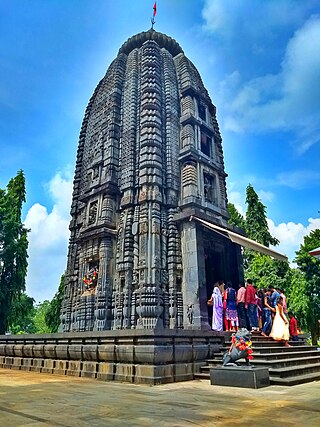
Mayurbhanj district is one of the 30 districts in the Odisha state of eastern India and the largest district in Odisha by area. The district's headquarters is located in Baripada, with other major towns including Rairangpur, Karanjia, and Bahalda. As of 2011, Mayurbhanj ranks as the third-most populous district in Odisha, following Ganjam and Cuttack.
Pāṇi is a surname used in India, found often in the state of Odisha. The surname Pāṇi is widely used in Orissa, Madhya Pradesh, and a large part of eastern and central India. This surname is used by Brahmins whose root is claimed to be traced to Ujjain of Madhya Pradesh and to the period of Kalidasa.
The Karan or Karana is a community found in the state of Odisha in India. The post of Karana used to be a professional designation that was occupied by literate peoples. They held Karanam posts in some parts of Andhra Pradesh, where they speak Odia and played a similar role in Odisha to that of the Kayasthas of West Bengal and Bihar. In the social hierarchy of Odisha they rank next to Brahmins. They exclusively served the ruling powers as their ministers, advisors, governors, military commanders, record keepers and dewans. They owned most Zamindaris in Odisha. They have the highest literacy caste-wise and are highly prosperous. Today they are a politically dominant community and have reigned over the politics of Odisha for 50 years.

Bira Surendra Sai was a native Indian as well as a regional freedom fighter from what is now Odisha. He fought against the British rule in India after they dethroned the rulers of the Sambalpur State as he was the legal heir.
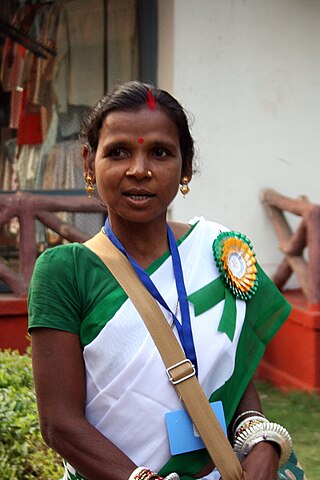
The Ho people are an Austroasiatic Munda ethnic group of India. They are mostly concentrated in the Kolhan region of Jharkhand and northern Odisha where they constitute around 10.7% and 7.3% of the total Scheduled Tribe population respectively, as of 2011. With a population of approximately 700,000 in the state in 2001, the Ho are the fourth most numerous Scheduled tribe in Jharkhand after the Santals, Kurukhs, and Mundas. Ho also inhabit adjacent areas in the neighbouring states of Odisha, West Bengal and Bihar bringing the total to 806,921 as of 2001. They also live in Bangladesh and Nepal.

Sambalpuri is an Indo-Aryan language variety spoken in western Odisha, India. It is alternatively known as Western Odia, and as Kosali, a recently popularised but controversial term, which draws on an association with the historical region of Dakshina Kosala, whose territories also included the present-day Sambalpur region.

Ghess is a village in Bargarh district of western Odisha in India. Its population in 2011 was 3,342. It is known for its culture and for its role in the Indian Rebellion of 1857.
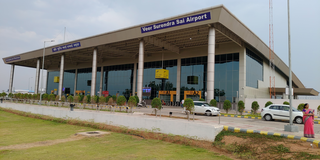
Veer Surendra Sai Airport, also known as Jharsuguda Airport, is a domestic airport serving Jharsuguda, Odisha, India. The airport is located 5 kilometres (3.1 mi) north-east from the city centre. The airport is located in Durlaga village, approximately 8.5 km (5.3 mi) from Jharsuguda Junction Railway Station. The airport is named after the revolutionary Veer Surendra Sai and it is the second commercial airport in the state of Odisha. The airport caters to areas like the districts of Jharsuguda, Sambalpur, Sundergarh, Bargarh, Debagarh, Bolangir, Subarnapur, Boudh of Orissa and Raigarh, Korba, Surguja, Jashpur districts of Chhattisgarh.
The Bhuiyan or Bhuiya are an indigenous community found in the Indian states of Bihar, Jharkhand, Madhya Pradesh, Odisha, Uttar Pradesh and West Bengal. They are not only geographically disparate but also have many cultural variations and subgroups.
Karaikella is a village situated at Chaibasa–Ranchi Main Road near Chakradharpur in the Indian state of Jharkhand.

The Odisha Pradesh Congress Committee is the unit of the Indian National Congress for the state of Odisha. It is responsible for organizing and coordinating the party's activities and campaigns within the state, as well as selecting candidates for local, state, and national elections in Odisha.
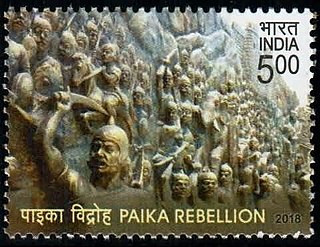
The Paika Rebellion, also known as the Paika Bidroha or Paik Rebellion. It was an early armed rebellion against Company rule in India in 1817. The Paikas rose in rebellion under their leader Bakshi Jagabandhu and projecting Lord Jagannath as the symbol of Odia unity, the rebellion quickly spread across most of Odisha before being put down by the Company's forces.

Sambalpur State, also known as Hirakhand Kingdom, was a kingdom founded in 1570. It ruled over Western Odisha and Eastern Chhattisgarh in central-eastern India prior to the Maratha occupation in 1800 AD. From 1849 AD, it was integrated with British Raj as a British District. Its capital was present-day Sambalpur city in Western Odisha.
Raja Arjun Singh was a prominent leader of the Indian Rebellion of 1857 in Singhbhum. He served as the Raja of Porahat zamindari estate in Singhbhum,. Arjun Singh had great influence over Kols who looked upon him with the "reverence due to the deity". He was the son of Raja Achyut Singh. During his rule the Dewan was Jagabandhu Patnaik.
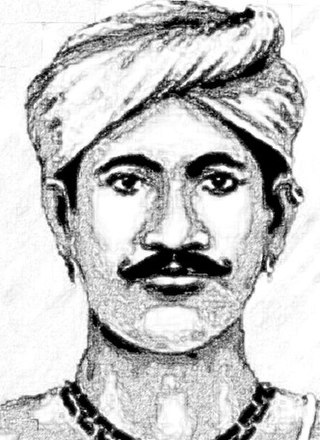
Madhab Singh Bariha or Madho Singh was the Binjhal Zamindar (landlord) of Ghess locality of Bargarh district in Odisha and was a close associate of Veer Surendra Sai in the Sambalpur uprising against the British East India Company. He was hanged to death at the age of 72 on 31 December 1858 at Jail Chowk of Sambalpur, after being caught in the same year for his ferocious and heroic resistance to the British takeover of the region with their appalling policies. Three out of his four valiant sons were martyred while the eldest was sentenced to life imprisonment. His granddaughter Purnima committed suicide after the British hanged her rebellious husband from the Sonakhan Zamindari at Raipur.
Kamal Singh Dao or only known as Kamal Singh was the son of Balabhadra Singh Dao, the Gond Zamindar (landlord) of Lakhanpur locality of Bargarh district of Odisha and was a major aide of Veer Surendra Sai during the Sambalpur uprising against the British. He along with his brothers Khageswar Singh and Neelambar Singh played an important role as one of the second in commands of Surendra Sai. Kamal's father Balabhadra Singh attained martyrdom in the earlier days of the rebellion. Kamal was treacherously killed in sleep while resting under a tree and when he was still in command of the rebels even though Surendra Sai himself had surrendered to the British. His brother Khageswar died under British imprisonment in Asirgarh jail.
The Bhumij Rebellion, also known as Jungle Mahal Uprising or Ganga Narain's Hungama was a revolt during 1832–1833 by Bhumij tribals based in the Dhalbhum and Jungle Mahal areas of the Midnapore district of the erstwhile Bengal state. It was led by Ganga Narayan Singh.
References
- ↑ Journal of Historical Research. Department of History, Ranchi University. 2007.
- ↑ Mahto, Shailendra (1 January 2021). Jharkhand Mein Vidroh Ka Itihas (in Hindi). Prabhat Prakashan. ISBN 978-93-90366-63-7.
- ↑ Paty, Chittaranjan Kumar (2002). History of Seraikella and Kharsawan States. Classical Publishing Company. ISBN 978-81-7054-359-6.
- ↑ Sen, Sunil Kumar (2008). Tribal Struggle for Freedom: Singhbhum 1820-1858. Concept Publishing Company. ISBN 978-81-8069-512-4.
- ↑ Reflections on the National Movement in Orissa. Orissa State Archives. 1997.
- ↑ Bhattacharya, Sabyasachi (2007). Rethinking 1857. Orient Longman. ISBN 978-81-250-3269-4.
- ↑ Sahu, N. K. (1985). Veer Surendra Sai. Dept. of Culture, Govt. of Orissa. pp. 130–135.
- ↑ Odisha Magazine. "The revolt of 1857 and Veer Surendra Sai" (PDF).
- ↑ ""A theoretical study on Prof. N.K. Sahu Contribution towards Modern History of Odisha" Dr. Sumitab Nayak. ISSN 2320-8708" (PDF). "A Theoretical Study on Prof. N.K. Sahu Contribution Towards Modern History of Odisha" Dr. Sumitab Nayak: 115–116.